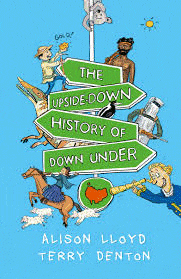
The Upside-Down History of Down Under
The Upside-Down History of Down Under
Alison Lloyd
Terry Denton
Puffin Books, 2018
304pp., hbk., RRP $A24.99
9780143788669
“The story of Australia starts with a piece of land that went for a swim. About 200 million years ago it floated away from Africa. Very very slowly. It was home to dinosaurs and giant animals, then the first Australians showed up. And for a long time this wild and wonderful land was a mystery to the rest of the world. Until the English decided it would make the best jail ever.”
When you read a blurb like that on the back of a book, you know you have got something somewhat different from the usual collection of Australian history books populating your 994 section, and indeed, different it is. Spanning that time when the ancient continents split till Federation in 1901, this book tells the history of this continent in a quirky way with a narrative that speaks to the reader in short chapters with engaging headings and lots of the sorts of illustrations that are so uniquely Terry Denton. It tells stories that are unfamiliar, challenges some long-held beliefs, and explores that which helped shaped 2018 Australia in a way that not only captures the imagination but makes the reader want to delve deeper.
Imagine, for instance, starting a study of the crossing of the Blue Mountains, with the sentence, “In 1813, three British gentlemen, Gregory Blaxland, William Lawson and William Wentworth, took four of their servants and four of their dogs out for a long mountain walk.” Or exploring the whaling industry under the title “How Australia got stinking rich”.
So many of our students groan at the thought of studying history, seeing it as having no relevance to their personal lives, and having been exposed to the “If it’s Year 5, it’s the Gold Rush” version of the curriculum, dry, dull and done-to-death. But if that same topic was embedded in a geological study of the formation of the gold, as alluded to in All that Glitters is Gold and followed up with the meaning of “golden soil and wealth for toil” it may well spark greater interest.
Why is gold so valued that people left all they knew and loved in a quest to find it? Why did the NSW government try to hide Edmund Hargreaves’ discovery? How was the Australian 2018 way of life shaped by those who were grubbing in the dirt 160 years ago?
This book is excellent for being the appetiser for the main meal – offering tasty tidbits that tantalise the tongue and make the reader want to indulge further. It’s a way of serving our history to our students which, in the hands of a skilful cook or even a dedicated diner, will open new worlds and new understandings that shows the broad spread of what has gone before.
To add to the experience, there is a wealth of support materials available on the author’s website.
